Storm shelters are a pretty formidable asset to have in the backyard.
More recently, in some parts of America, storm shelters have been the saving grace for both homes and businesses who are regularly affected by severe weather scenarios, but for some, they also represent safety against threats posed by man.
So what exactly are they?
They’re essentially an in-ground (or a well-constructed above-ground) unit that provides protection from natural disasters.
Sure, some have resorted to doing DIY shelters or rely on their basement as a method to seek shelter from severe circumstances, but with both of those comes the risk of becoming flooded, unstable, or, in the case of some DIY shelters, not being architecturally sound enough to support the earth above it.
While it may seem like a cheaper route to build your own shelter, there are a number of things that can go wrong, and when you are sitting in it with your family, you want to make sure you are completely safe and sound.
To ensure manufacturers only make storm shelters that are completely weather resistant and safe, they must comply with a set of standards known as the FEMA Standards which are to ensure that the design and construction of residential and community safe rooms and storm shelters will protect people during extreme-wind events such as tornadoes and hurricanes.
It should be noted that these are not verified to withstand nuclear attacks in comparison to what an underground fallout shelter would.
The FEMA standards for shelters don’t just cover tornadoes and storms, they are also a method of protection for other natural circumstances or manmade threats such as safety from shooters and burglars.
According to FEMA’s guidelines, safety storm shelters and safe rooms for your home or small business can:
- Help provide “near-absolute protection” for you and your family or employees from injury or death caused by the dangerous forces of extreme winds.
- Provide Near Absolute Protection to the occupants of a safe room.
- Ensure safe room occupants will have a very high probability of being protected from injury or death.
Households with adequate space in their garage or backyard are the most suitable for these structures as they do require some space which varies between each one.
However, these are also suitable for businesses and companies that might be situated in areas prone to serious storms, tornados, and disasters, or that may have other risks such as manmade concerns.
Residents in Oklahoma would fare well since authorities provide a reimbursement on storm shelters built in specific areas.
So let’s take a look at the 8 top storm shelters that can withstand extreme weather events.
Swisher Safety Residential Shelter
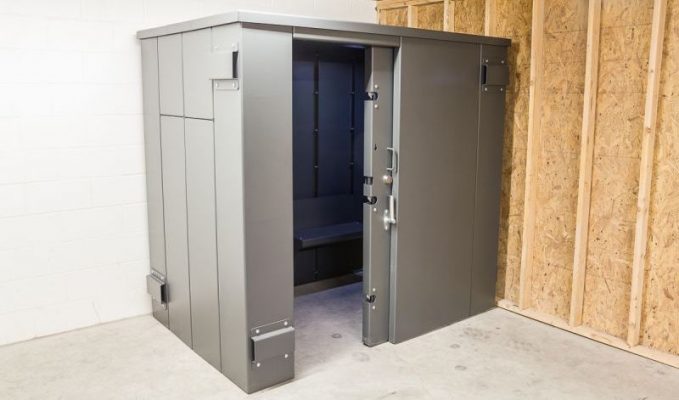
As far as space and capacity goes for value, the Swisher Residential Shelter has the best value. It is one of the cheapest available online, and houses up to six people in its 84″ by 39″ spacing with a reasonable height at 80″.
This is also one of the easiest storm shelters to set up as it is an above ground unit, so there’s no need to pay for excavation or have to dig your own pit for the structure. The structure is fixed by bolts, so if you decide to relocate the shelter it’s as simple as unbolting it, moving and rebolting.

The structure uses emergency panels for a quick exit and has a quick release sliding door so that if there is any debris outside, you are not pinned in the shelter trying to get out. The designers have also included:
- Shielded air ventilation for uninterrupted air flow
- Seats
- Shelves and gun rack
- Firm locking mechanism
- Anchor bolting to the flooring
- Shelter material that is 3/16″ thick
But does it comply with standard storm shelters guidelines? Yes. The Swisher has withstood testing of nine 15lb weights traveling at 100mph being fired at the shelter, so if you are in a tornado, it will withstand any impact thrown at it from up to 250mph winds. As for the FEMA standards, it exceeds their requirements. However, these shelters are not waterproof.
If you are wondering whether this type of shelter can protect you from threats posed by other people, yes it is also designed to be a safe shelter from manmade threats.
Granger Plastics In-ground Tornado Shelter
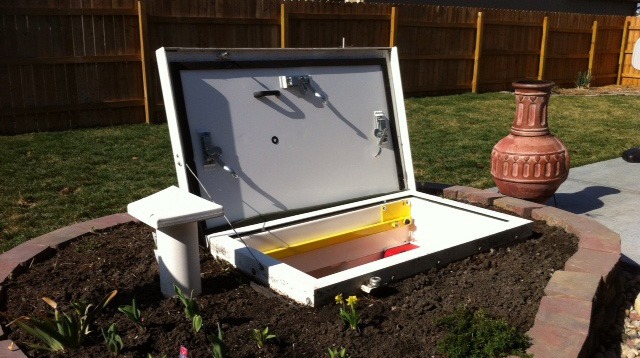

The Granger In-Ground Tornado Shelter is a pre-built system constructed from a highly durable polyethylene material making it a shelter that is maintenance free, practically indestructible and it won’t float.
What can also be referred to as an in-ground life pod, this tornado and storm shelter has an impressive amount of features, such as:
- Double Walled PE construction, 1/2″ thick each wall, 1,000+ year lifespan
- FEMA 320 exceeding triple-locking Aluminum Door w/ gas assisted Shock
- Molded in seating, exceeds FEMA standards for 3-5 Adults
- Molded in Stairs, Battery Operated LED Lighting System, 4″ Ventilation
- Articulating Handrails, 3 point locking system, stainless steel hardware
- Interior carpet
- Stainless steel hardware
The spacing is great in these storm shelters. This one specifically is one of the most popular on the shelter market and fits six or more people with enough space to also stock supplies.
As far as set-up goes, it doesn’t have to be anchored, so there is no excess work to be done in the set up of the shelter. According to Granger, the shelter takes four hours to set up and be ready to support life for the duration of an emergency.
Twister Pod Tornado Storm Shelters
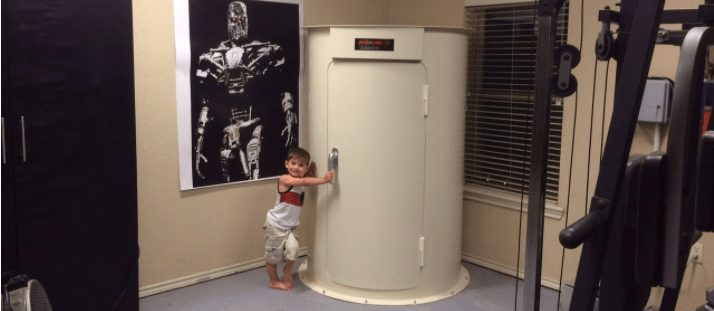
The Twister Pod is Survive-A-Storm’s small and practical (4ft diameter and 6ft tall) above ground shelter solution to keep up to four people safe in a tornado or storm.

While much smaller than other units in its field, this storm shelter is engineered to withstand EF5 tornado winds (200+mph) and is convenient to locate in just about anywhere in a home or property. For instance, these storm shelters can easily be installed in an existing garage, carport, or on an outside patio. Its small form factor means that you won’t displace much room in the garage.Because of their size, these shelters are ideal for small families or individuals that might not have the excess space to consider an in-ground option.
Even though it is compact, the Twister Pod storm shelter comes with:
- Built with Strong, 3/16″ heavy-duty steel rolled into a structural “pipe” design for durability provide the ultimate strength
- Cylindrical construction provides maximum protection and deflection of flying debris and against the most violent storms
- Powder-coated baked-on finish is rust and corrosion-resistant
- Triple-locking, single-lever latching mechanism with keyed door handle for extra safety and security
- Outfitted with welded-in bench seats on both sides provide comfort throughout the storm
- Weighs 980 lbs.
- At almost 6,000 PSI per anchor the shelter is held by over 70,000 PSI of ultimate tension strength
- Conduit connection provides ability to add electricity or phone
The setup time on these shelters is easy and be installed in as little as an hour by Survive-A-Storm’s technicians.
SafeHarbor Storm Shelters
Safe Harbor’s Storm Shelter is a fully welded storm shelter designed to be installed above ground and anchored on a concrete slab.

What makes it so good? It comes with:
- A fully welded door that has six (6) steel, 7/8” locking vault bolts that simultaneously engage with one handle motion and is over three inches thick with a 1/4″ steel front door plate, a 3/8” steel frame, and a 10 gauge rear door cover plate which encloses the door.
- An inside door system with 3/8” rack and pinion gears and drives, and a flanged doubler plate in the gear drive section for added strength.
- Door jamb is a 3/8” plate frame welded and gusseted for strength.
- Fully welded unit constructed of 1/4″ steel walls, base plate, gussets and front door plate.
- Roof is 1/4″ steel plate roll formed and fully welded to all four walls for added strength and rigidity.
- An anchoring kit for installation. Each anchor has an average of 8,030 lbs pull out strength in 4000 psi. concrete 4 1/2″ deep.
- Approval by a FEMA Certified Facility – Texas Tech National Wind Institute
These SafeHarbor storm shelters are 5ft x 4ft and 7ft tall, so they can easily fit 6 standing adults seeking reprieve from a severe storm and can be set up in as little as 1.5 hours.
Compact 10 ft. x 6 ft. Below-Ground Tornado Storm Shelters
By using a staircase that leads into the center of the underground storm shelter, the manufacturers provided bench seating all the way around the perimeter of the interior shelter, instead of just on three sides.

- 10-gauge steel construction with 1/4 in. floor and reinforcements for superior strength
- Strong, 1/4″ structural steel surrounds exterior to resist ground pressures
- Double-welded construction for a watertight seal
- Proprietary pressure tested to ensure no leaks
- Structural extended floor uses earth above to provide over 20,000 pounds to keep the shelter from floating
- Triple-locking, single-lever latching mechanism with keyed door handle
- Gasketed door with spring-loaded assists for easy opening and closing with Durable twin springs to provide “zero weight” door
- Perimeter steel bench seating for optimal comfort and structural support
- Plumbing and electrical connection hookups for added functionality
- Carpeted interior
Max 10 ft. x 6 ft. Below-Ground Tornado Storm Shelters
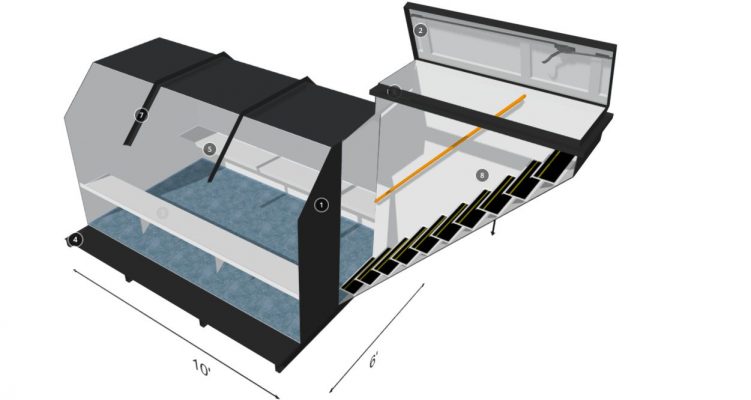
This huge Survive-a-Storm Max Model 10×6 underground steel storm shelter is ideal for large families or small businesses and can fit a whopping 16 occupants. If you are a family that likes a lot of space, or you have a huge stockpile of preparedness supplies, this might be the ideal shelter, or what is effectively an underground bunker.
This Max storm shelter measures 10 ft. long by 6 ft. wide, and can be buried in your yard in just a few hours.
It comes with a powder-coated finish so you have the same protection against rust and corrosion as an underground gas storage tank or cross-country pipeline. The shelter has bench seating on three sides, with a stairway entering from the surface and has a steel handrail and non-slip stair treads for extra safety.
What does this shelter come with? It has an impressive build with its survival features such as:
- 10-gauge steel construction with 1/4 in. floor and reinforcements for superior strength
- Strong, 1/4″ structural steel surrounds exterior to resist ground pressures
- Double-welded construction for a watertight seal
- Proprietary pressure tested to ensure no leaks
- Structural extended floor uses earth above to provide over 20,000 pounds to keep the shelter from floating
- Triple-locking, single-lever latching mechanism with keyed door handle
- Gasketed door with spring-loaded assists for easy opening and closing with Durable twin springs to provide “zero weight” door
- Perimeter steel bench seating for optimal comfort and structural support
- Plumbing and electrical connection hookups for added functionality
- Carpeted interior
Estate 5 ft. x 6 ft. Below-Ground Tornado Storm Shelters
The Survive-a-Storm Estate Model 5×6 underground storm shelter provides near-absolute protection against EF5 tornadoes and other violent windstorms. It measures 5 ft. L x 6 ft. W x 6 ft. tall and is comfortable and well-built being able to fit a maximum of 10 occupants.

The shelter’s coal tar epoxy finish protects it against rust and corrosion for years to come and is easy to install, being ready in your yard in just a few hours.
- 10-gauge steel construction with 1/4 in. floor and reinforcements for superior strength
- Strong, 1/4″ structural steel surrounds exterior to resist ground pressures
- Double-welded construction for a watertight seal
- Proprietary pressure tested to ensure no leaks
- Structural extended floor uses earth above to provide over 20,000 pounds to keep the shelter from floating
- Triple-locking, single-lever latching mechanism with keyed door handle
- Gasketed door with spring-loaded assists for easy opening and closing with Durable twin springs to provide “zero weight” door
- Perimeter steel bench seating for optimal comfort and structural support
- Plumbing and electrical connection hookups for added functionality
- Carpeted interior
Securall Community Storm Shelters

This Securall Tornado Shelter is designed large enough to provide protection at offices, schools, trailer and RV parks, campgrounds, construction sites and public venues. Its interior comes with enough room to safely house dozens of people during severe weather incidences, where residents, citizens or employees might not otherwise be able to find suitable shelter.
On top of the peace of mind these units offer to those working and living near them, they also reduce the risk to human life and therefore stand to reduce your insurance premiums as well.
Securall have designed a shelter to comply and exceed a lot of the standards on tornado shelters to be a community-based shelter provider. This shelter (TS10) does just that with its:
- Fully welded construction
- Heavy duty bolt down cement anchors to secure the unit in place
- Two vents both high and low with welded vents covers to ensure a quality airflow
- A FEMA approved storm-safe door
The size of this shelter is 10’w x 8’d and 7’3″ tall so as to ensure that there is enough space to fit its capacity of 16 people.
Quonset 10 ft. x 24 ft. Above-Ground Storm Shelters
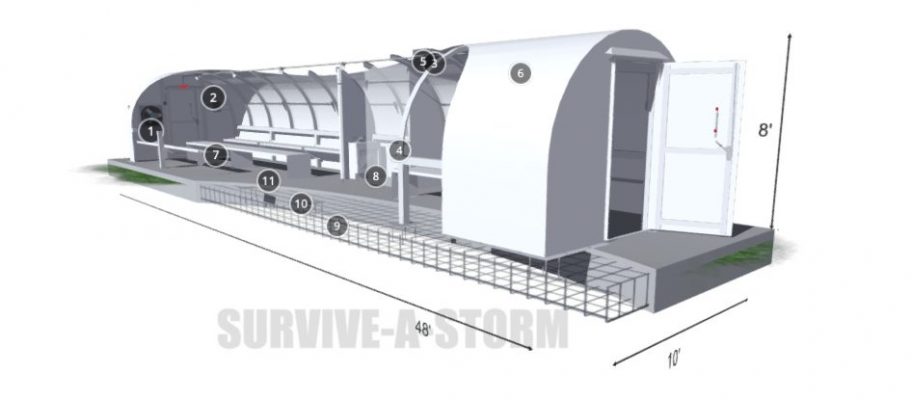
Survive-A-Storm’s 10-foot-wide Quonset Style above ground community tornado shelters are a favorite for many businesses because of their spacious design and capacity to fit large amounts of people (47 occupants) and are rated to withstand an EF5 tornado.
The setup of Quonset Storm Shelters are pretty straightforward. The steel is prefabricated in Georgia and shipped to the installation site and set by crane onto a massive steel reinforced concrete foundation. With companies like Oglethorpe Power Company and Proctor & Gamble using the 10-foot-wide shelters, they fit nicely within their facilities and can be sized to each company’s specific needs.

Survive-A-Storm is one of the most respected manufacturers of storm shelters, both below and above ground, and because of their wide use, they are heavily peer-reviewed and are constantly making improvements to the way they make their shelters. Because the Quonset is one of their latest innovations, it comes with an impressive list of specifics, such as having:
- Door dimensions: 3’ wide x 6’8” tall (ADA accessible)
- Built with ASTM A 36 ¼” heavy-duty steel plate and ASTM A 500 structural 3”x3”x3/8” rolled angle, 4’ on center and 4”x4”x1/4” square tubing, 8’ on center for utmost strength and durability
- Round design provides maximum protection for deflection of flying debris
- Powder-coated baked-on finish is rust and corrosion-resistant
- Triple-locking, single lever latching mechanism with keyed door handle for extra safety and security
- Removable perimeter benches provide ability to increase/decrease seating/standing capacity
- Chemical toilet with privacy enclosure included
- 50 amp 240 volt electrical load center with lighting, exhaust fan system and electrical outlets included
- Stand-by generators and solar panel kits available (call for pricing)
- Factory installation and foundation available (call for pricing)
- Shelters meet FEMA 361 and ICC 500 codes with 250 MPH wind rating. Wall sections and doors successfully passed Texas Tech Wind Research Institute simulated tornado missile impact test. Shelters are designed and sealed by a Structural Engineer
- 18” thick concrete foundation is provided with two layers of #5 rebar installed 9” and 16” on center. 5/8” x 12” x 12” embed steel plates with Nelson Studs are precast into the concrete and all columns are welded to precast plates per Engineer’s specifications creating the strongest anchoring on the market. Optional 12” foundation with 24” perimeter footing is available in areas with frost line requirements.
You might also be interested in exploring the intricacies of building a bomb shelter.

